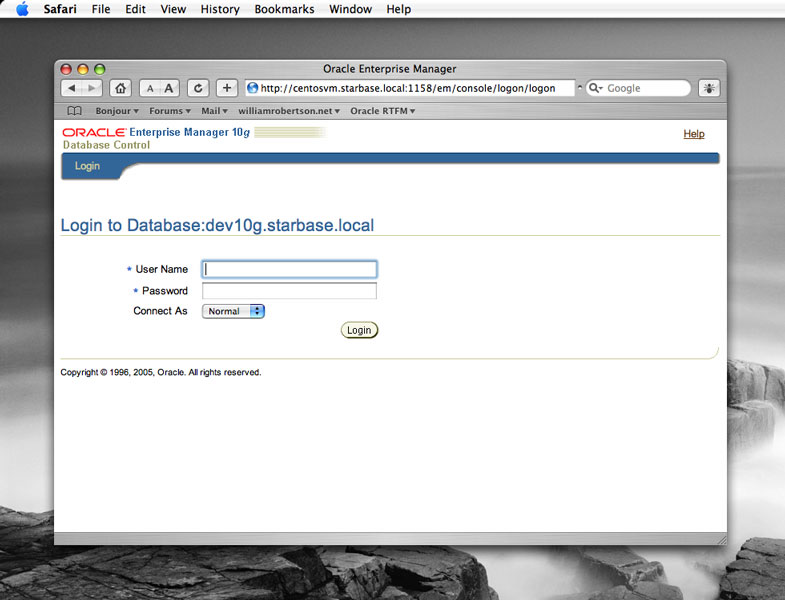- How to install SQLite in OS X Installing SQLite on your Mac is pretty straightforward. Just follow these steps: Head over to SQlite.org and download the C source code file, named.
- Nov 12, 2014 OS X standard is to put the preferences item on the application main menu, right below ‘About Oracle SQL Developer’ Ehsan 5 years ago You are a life saver!
- Sql Developer uninstall on Mac. Ask Question Asked 5 years. Remove the.sqldeveloper folder - that will remove all of the application data files for your OS X account - things like SQL History. How to install Java 8 on Mac. Git is not working after macOS Update (xcrun: error: invalid active developer path (/Library/Developer.
Feb 10, 2013 What are the connection details you used in sql devleoper in windows 7? I don't think there is a supported database installation for Mac OS/X any more. If you database is remote, then you can use the same connection details to connect from Mac OS. If it is local to windows 7, you could connect your mac to the windows 7 database.
- Written by: ilmarkerm
- Category: Blog entry
- Published:
Jan Karremans just today published a similar article about Mac and Instant client, but the goal of my blog post is to get SQL Developer connected through Instant Client.
JDK
First you need Java installed, I installed 64-bit JDK8, but it would be better to install 64-bit JDK7, since SQL Developer 4.0 is not supported on JDK8.
SQL Developer
When I’m writing this, SQL Developer 4.1 is in Early Adopter release and 4.0 is in production. I installed SQL Developer 4.0.3.
Oracle Instant Client
There is another reason to choose SQL Developer 4.0 over 4.1 – 4.1 requires version 12.1 of the Oracle Client and that is not yet released for MacOS. SQL Developer 4.0 requires Oracle Client 11.2.0.3 and that is available for MacOS. I downloaded Instant Client 11.2.0.3 (64-bit – since I installed 64-bit JDK): instantclient-basic-macos.x64-11.2.0.3.0.zip and instantclient-sqlplus-macos.x64-11.2.0.3.0.zip to be precise. I unzipped both these files under /opt so my Instant Client installation directory is /opt/instantclient_11_2. After unzipping, Instant Client installation instructions require creating the following symlinks:
Configuring SQL Developer
Open SQL Developer, open Preferences and go to Database > Advanced. Configure Oracle Client paths and check Use Oracle Client and Use OCI/Thick driver boxes. Here is the sample screenshot from my settings.
When you press the Configure button to set the Oracle client path, there is also a button to Test if the Client was loaded correctly. Currently this test should fail.Setting the environment variables
We need to set two environment variables: DYLD_LIBRARY_PATH to make sure applications can find and load the instant client libraries and TNS_ADMIN so instant client could find sqlnet.ora and tnsnames.ora files. In my case sqlnet.ora is essential, since I need to use Radius authentication.
First I added these environment variables to ~/.profile:

After restarting terminal and verifying that these environment variables are indeed set, execute SQL Developer app directly from terminal by executing open /Applications/SQLDeveloper.app/.

Open preferences and press the Oracle Client Test button again, now the test should succeed and SQL Developer is connected through Instant Client.
All good! Great success! Guess again… Close SQL Developer and launch it from Docker/Launchpad and you will see the Oracle Client test failing again. This is because the environment variables under ~/.profile or ~/.bash_profile are loaded only inside Terminal.Setting environment variables on login
This seems to be the most complex part of this story since it seems to change with every MacOS release. The method that is working for me under Yosemite (and in no way am I declaring that it is the best method, I am a Mac newbie after all), is this:
Open application Script Editor and paste the following AppleScript there:
Yes, it is also necessary to set TNS_ADMIN, since setting the TNS admin directory path under SQL Developer preferences does not work if you need to use specific settings in sqlnet.ora, for example authentication.
Install Sql Server On Mac
Save the script and in the save dialog set File format: Application. And finally System settings -> Users & Groups -> Login items press + sign and select the application you just saved. Now, log out from MacOS and log back in. Now SQL Developer should work with Instant Client even when you launch it from Launchpad.
I got this method from a Stackoverflow thread.
Today I could not install any SQL Developer extension on my Mac OS X machine. I did not get an error message during the installation. After a restart of SQL Developer the extension simply was missing. When I tried to re-install it – selecting “Check for updates…” in the “Help” menu – I’ve got the following message:
Restarting SQL Developer did not help. This message was shown again and no extension was installed. I’ve tried to remove the $HOME/.sqldeveloper directory and reinstalled SQL Developer, but the problem persisted. I’ve tried SQL Developer version 4.0.3.16.84 and the brand new version 4.1.0.19.07. Same result.
Pl Sql Developer Mac
What was the problem?
After some analysis I found the root cause. SQL Developer creates a file named jdeveloper-deferred-updates.txt in the directory $HOME/.sqldeveloper (e.g. /Users/phs/.sqldeveloper). This file is read and copied into a temporary directory as part of the installation process. On non-Windows platforms the name of the temporary directory is $TMPDIR/$USER (e.g. /var/folders/lf/8g3r0ts900gfdfn2xxkn9yz00000gn/T/phs). If a file with such a name already exists, the directory cannot be created and the whole installation of the extension fails.
Install Sql Developer Mac Os X Download
What is the solution (workaround)?
Open a terminal window (e.g. type terminal in the spotlight window) and execute the following command to delete the existing temporary file, which is causing the name conflict:
How To Install Oracle Sql Developer On Mac Os X
Afterwards restart SQL Developer and install the extension. Restart SQL Developer once again to complete the installation.